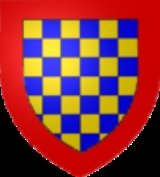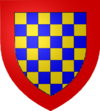
Robert II of Dreux
Encyclopedia

Robert I of Dreux
Robert I of Dreux, nicknamed the Great , was the fifth son of Louis VI of France and Adélaide de Maurienne. Through his mother he was related to the Carolingians and to the Marquess William V of Montferrat.In 1137 he received the County of Dreux as an appanage from his father...
, Count of Dreux, and Agnes de Baudemont, countess of Braine, and a grandson of King Louis VI of France
Louis VI of France
Louis VI , called the Fat , was King of France from 1108 until his death . Chronicles called him "roi de Saint-Denis".-Reign:...
.
He participated in the Third Crusade
Third Crusade
The Third Crusade , also known as the Kings' Crusade, was an attempt by European leaders to reconquer the Holy Land from Saladin...
, at the Siege of Acre and the Battle of Arsuf
Battle of Arsuf
The Battle of Arsuf was a battle of the Third Crusade in which Richard I of England defeated Saladin at Arsuf. Following a series of harassing attacks by Saladin's forces, battle was joined on the morning of 7 September 1191...
. He took part in the war in Normandy
Normandy
Normandy is a geographical region corresponding to the former Duchy of Normandy. It is in France.The continental territory covers 30,627 km² and forms the preponderant part of Normandy and roughly 5% of the territory of France. It is divided for administrative purposes into two régions:...
against the Angevin Kings between 1193 and 1204. Count Robert had seized the castle of Nonancourt from Richard I of England
Richard I of England
Richard I was King of England from 6 July 1189 until his death. He also ruled as Duke of Normandy, Duke of Aquitaine, Duke of Gascony, Lord of Cyprus, Count of Anjou, Count of Maine, Count of Nantes, and Overlord of Brittany at various times during the same period...
while he was imprisoned in Germany in late-1193. The count also participated in the Albigensian Crusade
Albigensian Crusade
The Albigensian Crusade or Cathar Crusade was a 20-year military campaign initiated by the Catholic Church to eliminate Catharism in Languedoc...
in 1210. In 1214 he fought alongside King Philip Augustus at the Battle of Bouvines
Battle of Bouvines
The Battle of Bouvines, 27 July 1214, was a conclusive medieval battle ending the twelve year old Angevin-Flanders War that was important to the early development of both the French state by confirming the French crown's sovereignty over the Angevin lands of Brittany and Normandy.Philip Augustus of...
.
Marriages and Children
His first marriage with Mahaut of Burgundy (1150–1192) in 1178 ended with separation in 1181 and produced no children. The excuse for the annulment was consanguinity. Mahaut and Robert were both great-great grandchildren William I, Count of BurgundyWilliam I, Count of Burgundy
William I , called the Great , was Count of Burgundy and Mâcon from 1057 to 1087. He was a son of Renaud I and Alice of Normandy, daughter of Richard II, Duke of Normandy...
and his wife Etiennete and they were both Capetian
Capetian
Capetian is an adjective, used to describe either:* The House of Capet, also called the Direct Capetians – the ruling family of France between 987 and 1328* The Capetian dynasty, a term applied to all direct descendants of Hugh Capet...
descendants of Robert II of France
Robert II of France
Robert II , called the Pious or the Wise , was King of France from 996 until his death. The second reigning member of the House of Capet, he was born in Orléans to Hugh Capet and Adelaide of Aquitaine....
.
His second marriage to Yolande de Coucy (1164–1222) produced several children:
- Robert IIIRobert III of DreuxRobert III of Dreux , Count of Dreux and Braine, was the son of Robert II, Count of Dreux, and Yolanda de Coucy. He was given the byname Gasteblé Robert III of Dreux (1185–1234), Count of Dreux and Braine, was the son of Robert II, Count of Dreux, and Yolanda de Coucy. He was given the byname...
(c. 1185–1234), Count of Dreux and Braine, - PeterPeter I, Duke of BrittanyPierre Mauclerc , also known as Peter of Dreux or Pierre de Dreux, was duke of Brittany jure uxoris from 1213 to 1221, then regent of the duchy from 1221 to 1237 as well as Earl of Richmond from 1219 to 1235.-Biography:He was the second son of Robert II, Count of Dreux...
(c. 1190–1250), Duke of Brittany. - Henry of Dreux (c. 1193–1240) Archbishop of ReimsArchbishop of ReimsThe Roman Catholic Archdiocese of Reims is an archdiocese of the Latin Rite of the Roman Catholic Church in France. Erected as a diocese around 250 by St. Sixtus, the diocese was elevated to an archdiocese around 750...
and - John of Dreux (c. 1198–1239), Count of Vienne and Mâcon.
- Philippa (1192–1242), who married Henry II of BarHenry II of BarHenry II of Bar alternately Henri II of Bar was a Count of Bar who reigned from 1214 to 1239. He died in Gaza while on Crusade.-Spouse and children:In 1219 he married Philippa de Dreux , the daughter of Robert II of Dreux....
. - Alix of Dreux, married Walter IV of Vienne, Lord of Salins, then married Renard II of Choiseul.
Tomb
Count Robert's tomb bore the following inscription, in Medieval LatinMedieval Latin
Medieval Latin was the form of Latin used in the Middle Ages, primarily as a medium of scholarly exchange and as the liturgical language of the medieval Roman Catholic Church, but also as a language of science, literature, law, and administration. Despite the clerical origin of many of its authors,...
hexameters
Dactylic hexameter
Dactylic hexameter is a form of meter in poetry or a rhythmic scheme. It is traditionally associated with the quantitative meter of classical epic poetry in both Greek and Latin, and was consequently considered to be the Grand Style of classical poetry...
with internal rhyme:
- Stirpe satus rēgum, pius et custōdia lēgum,
- Brannę Rōbertus comes hīc requiescit opertus,
- Et jacet Agnētis situs ad vestīgia mātris.
Of which the translation is: "Born from the race of kings, and a devoted guardian of the laws, Robert, Count of Braine, here rests covered, and lies buried by the remains of his mother Agnes."
It is also dated Anno Gracię M. CC. XVIII. die innocentum, that is, "In the Year of Grace 1218, on the Feast of the Holy Innocents."

